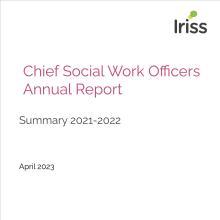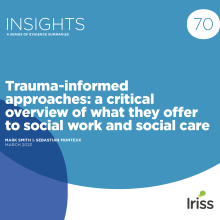Summary
This evidence summary seeks to identify some best practice recruitment strategies from voluntary social care and other relevant sectors and industries. It provides background information about social care recruitment in Scotland and identifies the key challenges identified in the evidence. It identifies values based recruitment as one of the main approaches to recruitment being taken in health and social care in Scotland, and identifies key sources of information about the benefits and impact of the approach. Evidence of good practice and impact are identified. Some examples of ideas for recruitment strategies employed beyond the social services sector are provided. Sources of training and further information are listed.
Introduction
This evidence summary seeks to identify some best practice recruitment strategies from voluntary social care and other relevant sectors and industries.
About the evidence presented below
A report produced by Why Research on behalf of the Social Work Services Strategic Forum in 2016 undertook a literature search and identified a lack of evidence around recruitment and retention methods used and the outcomes from/value of these, as well as lack of evidence around present and anticipated difficulties in recruitment and the causes of these difficulties and specific services/posts affected.
It should be emphasised that "there is no 'one size fits all', 'quick win' solution to the challenges faced by the sector" (Figgett 2017) and issues of recruitment should not be viewed in isolation from issues of retention. Additionally, where evidence of what works exists, it is not able to isolate the impact of specific actions. It is based on the perceptions of the people 'trying things out' and reporting on what they think might have been the thing that worked. This echoes the findings of Why Research who identified a lack of evidence to show the extent to which services are employing 'short-measures' (rather than longer-term (structural) approaches), which would include recruitment campaigns.
Accessing resources
We have provided links to the materials referenced in the summary. Some of these materials are published in academic journals and are only available with a subscription through the The Knowledge Network with a NHSScotland OpenAthens account. The Knowledge Network offers accounts to everyone who helps provide health and social care in Scotland in conjunction with the NHS and Scottish Local Authorities, including many in the third and independent sectors. You can register here.
Background
There are over 190,000 people working in social services in Scotland, which is supplied from a mix of providers: 41% private sector, 32% public sector and 27% voluntary sector (Why Research 2016). Recruitment is a significant challenge across the board. The Care Inspectorate reported in 2017 that over a third of social care services across Scotland have reported unfilled staff vacancies in the previous year. Reasons for vacancies being hard to fill include:
- Too few applicants
- Too few applicants with experience
- Too few qualified applicants
- Competition from other service providers
- Candidates unable to work the hours needed
- Competition from other types of work
- Can’t afford wage demands
- Cost of living in the area is too high
Scottish Care (2015) identified other issues relating to the private and voluntary sectors:
- Low pay and conditions
- Challenge of geographical recruitment
- Fragmenting working time
- Zero-hours contracts
- Diversity of pay enhancement practices
Index 1 of Why Research’s (2016) report on recruitment and retention in the social service workforce in Scotland provides a comprehensive list of documents relating to the current situation and challenges associated with recruitment and retention, including several with content about and/or applicable to the voluntary sector.
Further background reading
Cunningham, I and Nickson, D (2013)Public sector austerity, personalisation and the implications for the voluntary sector workforce. Report for Community Care Providers Scotland, Edinburgh (pdf)
This report explores the introduction of personalisation in an era of austerity and its impact on workforce and service quality, reporting findings from a qualitative study of five local authorities (LAs) and five voluntary organisations (VOs). The report discusses the role of the direct voluntary sector employer as a “key actor” in shaping employment policies and procedures in the context of personalisation. It discusses the commitment of the employees in the sector but identifies their need for sufficient income. It also identifies the barriers and disincentives PAs experience (p.9).
The report outlines data from voluntary sector providers with regard to changes to employment conditions in the light of efforts to bring more choice to people accessing services in an era of austerity. It identifies tailored adverts, job descriptions and person specifications and profiles of workers to fit service user needs as approaches being taken in recruitment.
Recommendations include continuation and further development of dialogue among unions and employers regarding pay and conditions, including a specific focus on the potential and actual implications of personalisation.
Rogers, SE et al. (2013) Challenges and opportunities in healthcare volunteer management: insights from volunteer administrators. Hospital Topics, 91(2), pp.43–51 (Available with NHSScotland OpenAthens login)
This study of 105 hospitals in five states in the northeast and southern United States found that primary challenges to facing healthcare volunteer management include volunteer recruitment and retention, administrative issues, and operational difficulties brought about by the current economic crisis.
Values based recruitment
Values based recruitment (VBR) is an approach that attracts and selects applicants on the basis that their individual values and behaviours align with the values of the organisation/sector. The VBR approach is one of many being taken across the health and social care sector in the UK, including the NHS:
VBR is just one of many national programmes of work and initiatives being undertaken across the health and social care system to address values, and it is important the sector takes a whole system approach to the values based employment journey (NHS 2016)
The sources outlined below provide further information about VBR potentially relevant to the voluntary social care context:
ARC Scotland (2015) A collective approach to improving recruitment in the social care sector (pdf)
This short report sets out the learning from a small initiative to pilot a partnership approach to address challenges with staff recruitment experienced by social care organisations in Fife. It hopes to inform the development of similar initiatives that help to address this issue within the provision of care and support in Scotland. It includes feedback from participating organisations and key learning points. These include:
In an introductory programme, it is more important to focus on values, attitudes and peoples lived experience- rather than than skills and knowledge, which can be developed once people have progressed to employment.
Consilium Research and Consultancy (2016) Study into the impact of a values based approach to recruitment and retention. Skills for Care (pdf)
This report presents the findings of a study to assess the impact of a values based approach to recruitment and retention. Findings include that “a ‘values based’ approach was stated to be more effective than ‘traditional’ methods in gaining an understanding of, and building a relationship with, candidates”. The report identifies barriers to adopting a values based approach that may need to be considered when exploring recruitment strategies.
Goode, J (2014) Values-based recruitment toolkit. Evaluation of 12 month pilot. Skills for Care (pdf)
This report presents the findings of a 12 month evaluation project for a toolkit based on a model of values-based recruitment. The evaluation explores tools such as:
- Leadership Qualities Framework for Adult Social Care: sets out what good behaviours look like at every level of the social care workforce
- Example job advertisements that promote social care values and help you to prepare your own
- Online personality profiling questionnaire and a resultant profile report to give a basic profile of a candidate’s value-base
- Suggested interview questions that enable candidates to demonstrate values in action
- Skills for Care’s Qualifications and Credits Framework signposts the user to information and advice on skills and qualifications to look for
- Finders Keepers: a range of ways to improve recruitment and retention
- A Question of Care: A Career for YOU? Which provides a situational judgement test. This is not a substitute for personality profiling but is a useful addition to the toolkit and helps to inform the recruitment process
Manthorpe, J et al. (2016) Doing, being and becoming a valued care worker: user and family carer views (pre-print)
This paper presents and discusses data from a study of the views of people using social care services and of family carers about their care workers, what they do that is valued, what are valued characteristics, and how people become or are made ‘good’ care workers. The authors conclude:
With greater user and carer engagement in determining care work outcomes and recruitment, the values seen as important by care users and carers may need to be considered in respect of ‘what is valued’ and, if it is possible and appropriate, linked to value based tools that measure and analyse personality characteristics.
Other evidence
Brown et al. (2011) Strengthening the Direct Service Workforce in Rural Areas (pdf)
This report aims to provide examples of direct service-related strategies that US states and rural agencies have implemented to overcome common recruitment challenges. In terms of general recruitment and retention strategic planning, the following information is provided:
Increasing the size of the available workforce provides the most direct solution to the shortage of rural direct care workers. The Annapolis Coalition’s report for the Substance Abuse and Mental Health Services Administration An Action Plan for Workforce Development contains a section on workforce recruitment/retention of the behavioral health workforce in rural areas.
The recommendations were developed through a strategic planning process that included two conferences in 2003 and 2005 and getting input from an expert panel. Although this report focuses on a specific segment of the rural direct service workforce, many of its recommendations can be generalized to the wider group of direct service providers. The report described the following action plan goals for rural behavioral workforce development:
- Increasing elders’ and people with disabilities’ level of self-direction and individual responsibility for their own care
- Educating community on identifying long-term care infrastructure needs
- Implementing recruitment strategies (grow-your-own approaches), including participant-directed service models
- Increasing supply of effective training opportunities
- Fostering leadership development
- Enhancing infrastructure to support and coordinate workforce development
- Implementing national research and evaluation agenda on workforce development
Dimensions (2017) Aspire care worker development programme (personal contact)
Dimensions is a care provider for 3,500 adults with learning disabilities and autism in England and Wales. They saw care worker applications triple in a month after it transformed its recruitment process to include an initial guaranteed telephone interview, open days to meet clients, and interactive assessments it called “auditions”.
Dimensions have provided us with an awards submission, including evaluation data, that resulted in them receiving three nominations at the 2017 Business Culture Awards. We have provided this to the organisation that requested this Outline, but it was not intended for public distribution. Anyone interested is welcome to contact Simon Gosney at Dimensions for further information. Forthcoming trade press articles will also provide information about the scheme.
Figgett, D (2017) Recruitment and retention in adult social care: secrets of success. Learning from employers what works well. Leeds: Skills for Care (pdf)
This report is part of the Skills for Care Recruitment and Retention Strategy outlined above. Based on survey research of social care employers across England, the report examines good practice in recruitment planning, attracting people to apply for vacancies and encouraging people to work in adult social care. It links to the Skills for Care Finding and Keeping Workers toolkit and other resources that may be useful for adult social care employers and individual employers (pp.9-10). The findings of the study are based on the reported behaviours and actions of employers when seeking to recruit, and their perceptions of what has worked for them. The report provides recommendations for adult social care employers and individual employers.
Green, A et al. (2014)Determinants of the composition of the workforce in low skilled sectors of the UK economy: social care and retail sectors. Warwick Institute for Employment Research (pdf)
This report seeks to develop further understanding of the supply and demand side factors that affect the composition of the low-skilled labour market, with particular reference to the social care and retail sectors. It includes findings around what methods are used by employers to recruit low-skilled labour and what job search methods workers in low-skilled jobs typically use.
Johnston, L et al. (2017) Building the future social care workforce: a scoping study into workforce readiness, recruitment and progression in the social care sector. London: Social Care Institute for Excellence (pdf)
Section 4 of this report by the JP Morgan and the Social Care Institute for excellence focuses on evidence around good recruitment practice. They highlight a statistical evidence gap in the efficacy of recruitment methods (p.32) but discuss that qualitative research indicates agency recruitment is inefficient. They suggest values-based approaches to recruitment as an alternative.
Leviton et al (2006) Faith in action: capacity and sustainability of volunteer organizations. Evaluation and Program Planning, 29, pp.201-207 (Available with NHSScotland OpenAthens login)
This paper considers the role of management and experience on volunteer recruitment. The authors find that experienced directors recruit and retain volunteers more readily, build relationships with community partners, and are more likely to engage in effective strategic management leading to mission fulfillment (Leviton, Herrera, Pepper, Fishman, & Racine, 2006).
Mulholland, S et al (2016) Social Work Services Strategic Forum recruitment and retention project: survey findings (pdf)
Evidence from a survey conducted in Scotland in 2016 indicates that “recruitment materials and support for applicants is seen as the most useful way of mitigating against recruitment challenges” (p.44). Other methods included “increasing the number of young people entering the profession and selling careers in the social service sector to young people” (p.44). The report provides examples, such as: giving talks at career events; college recruitment drives; modern apprenticeships; placement and shadowing opportunities; voluntary placements; social media engagement; partnership with Princes Trust. No evidence was available to reflect on the efficacy of these methods.
Skills for Care (2014) Adult social care workforce recruitment and retention strategy 2014-17 (pdf)
Section Five of this report outlines actions and priorities around recruitment to “attract more people with the right values and skills to work in the sector” and “encourage and enable better recruitment practices” (pp.22-29). The report emphasises the importance of measuring outcomes from these actions, stating that “robust and consistent research and evaluation covering all of the major programmes to ensure that the differences they are making to the sector can be accurately identified” (p.38) and that research and evaluation reports relating to the programmes in the strategy will be made available.
Recruitment beyond the social services sector
Duff, C and Logan, E (2015) Investigating the roots of involvement in the natural heritage: marketing and motivation and their influence on volunteer recruitment and retention in the natural heritage sector. Scottish Natural Heritage Archive Report No. 023 (pdf)
This research was undertaken during 2008 but remained unpublished until 2015. Although the sector and demographics are likely to differ, this report may provide some useful insight into the impact of understanding volunteer motivations, branding and marketing, and customs and practice as recruitment strategy.
Lacey, M and Lavery, T (2007) Recruitment and retention lessons from beyond the social services sector (pdf)
This report, commissioned by Iriss and funded by the Voluntary Sector Social Services Workforce Unit, identifies a range of ways that other sectors have attempted to solve challenges such as competition for scarce skills, high turnover, and career progression.
The voluntary sector case studies provided highlight examples of actions taken to increase recruitment and support under-represented sections of the community. They include:
- Carefully tailored qualifying training provision within niche employment markets
- Addressing trainees’ specific barriers
- Working with employers to adapt recruitment processes
- Outreach marketing of job content
- Design of application forms
- Making interviews more applicant friendly
- Providing ongoing mentoring and support to employees along with their employers
The authors emphasise that the case studies are illustrative and do not necessarily represent best practice.
Poudel, A (2017) Improving volunteer recruitment and retention practices - Finnish Red Cross, Helsinki and Uusimaa District (pdf)
This Masters dissertation research explores issues in volunteer recruitment and retention in the Finnish Red Cross. It outlines a set of recommendations for improving recruitment, in addition to “practical tools for the volunteer leaders and volunteers to self-manage and increase the efficiency of the volunteer recruitment and retention process”. Although a significant element of recruitment and retention in this context relates to safety, there is also an administrative element that may be relevant. The identification of particular ‘pinch points’ may also be useful.
Training and tools
NHS Employers (2017) Tools for VBR (website)
The tools in this area have been developed to assist you in implementing values based recruitment (VBR) for your organisation and embedding values across post employment practices. Tools include:
- Readiness checklist
- Values mapping tool
- Behaviour framework
- HEE National VBR Framework
Skills for Care (2018) Getting started with values and behaviours-based recruitment (training courses)
Various dates and locations in 2018
Free to attend
Included in course:
- What workplace values are
- The benefits of establishing workplace values
- Working with others to develop and agree workplace values
- Communicating your values
Fife Voluntary Action (2018) Volunteer Management Course 2: Effective volunteer recruitment (training courses)
9.30am-1.00pm, Wednesday 14 February 2018
New Volunteer House, 16 East Fergus Place, Kirkcaldy, KY1 1XT
Free to attend
Included in course:
- Motivations for volunteering
- Developing opportunities
- Methods of recruitment
- Recruitment messages
- Recruitment strategies
Turro (2017) Why verbal referencing in social care is key to successful hires (website)
Walker, R (2015) What are the barriers to successful recruitment within Social Care? LinkedIn (website)
References
- The Care Inspectorate (2017) Staff vacancies in care services 2016 (pdf)
- Figgett, D (2017) Skills for Care: recruitment and retention in adult social care: secrets of success (pdf)
- Scottish Care (2015) In the front line: social care providers survey report on recruitment and retention 2015 (pdf)
- Why Research (2016) The position on recruitment and retention in the social service workforce in Scotland: literature review report (pdf)




